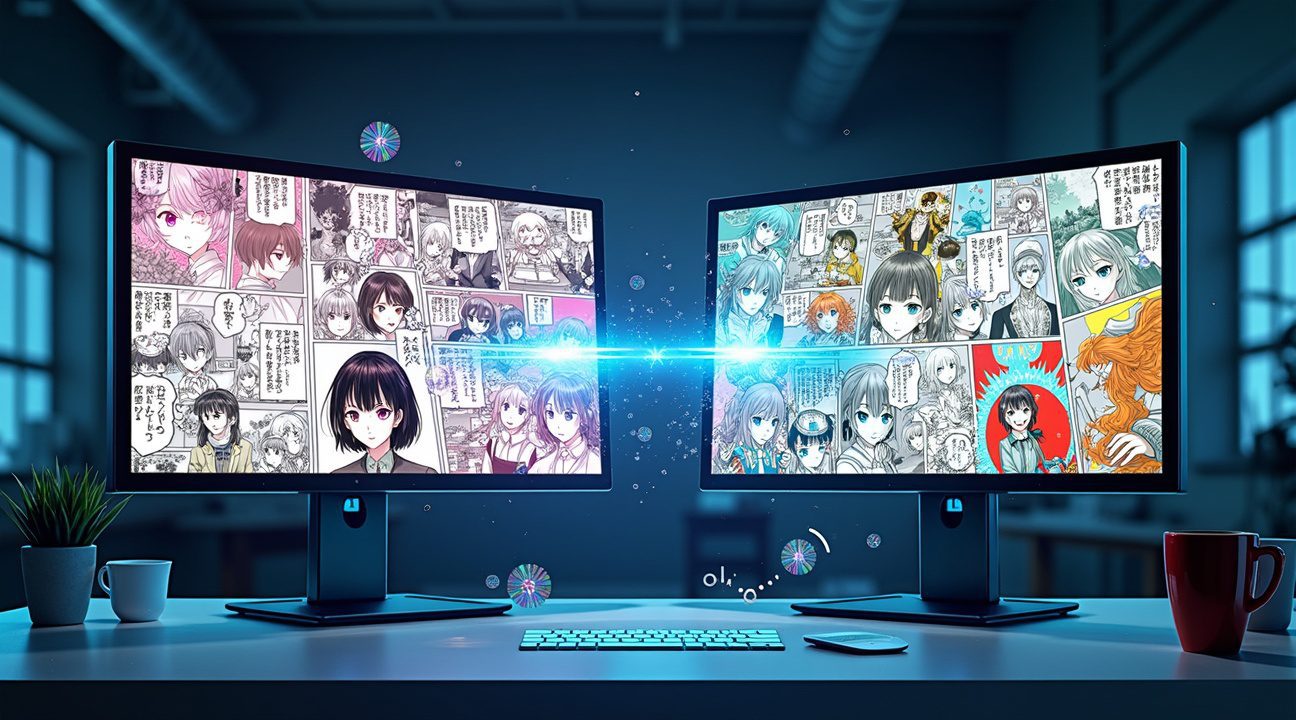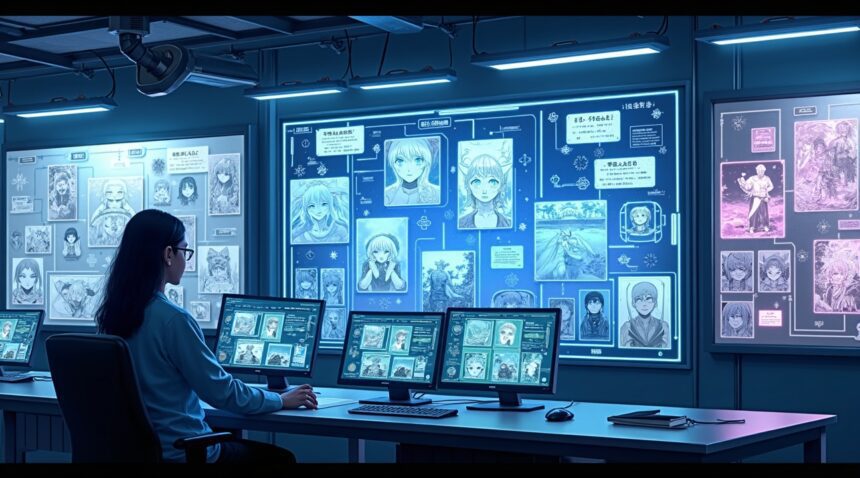Google is currently testing a groundbreaking experimental image generator model that allows select users to translate manga from East Asian languages into English while simultaneously adding color to black-and-white artwork using a single prompt.
Key Takeaways
- The model integrates multiple AI technologies including specialized optical character recognition (OCR) for East Asian scripts, highly customizable machine translation chains, and a system known as ‘mc2’ for advanced image colorization. Users can fine-tune their results through adjustable parameters.
- Performance metrics are impressive, with the Conditional Generative Adversarial Network (C-GAN) architecture achieving Structural Similarity Index (SSIM) scores ranging from 0.85 to 0.90. This marks a significant improvement over previous methods such as Neural Style Transfer and CycleGAN, which struggled to preserve both structural integrity and color fidelity.
- Users enjoy extensive customization, including options to define font paths, set detection thresholds, enable batch processing, and choose from multiple output formats like PNG, JPEG, PSD, and PDF—ideal for professional publishing workflows.
- The system caters to a range of use cases, from fan translation groups and small-scale publishers to digital artists and organizations involved in archival preservation or modernization of classic manga series.
- Initial reports from early access testers highlight efficient processing speeds, averaging 2–3 minutes per page on standard consumer-grade hardware. For users with access to cloud services, processing time can drop even further, particularly for high-resolution pages.
How the Integrated Translation and Colorization Pipeline Actually Works
Google’s experimental model functions as a comprehensive manga processing system that combines multiple AI technologies into one streamlined workflow. The system integrates optical character recognition (OCR), machine translation, inpainting technology, and colorization algorithms to transform manga panels with a single user prompt.
Core Processing Components
The translation pipeline begins with specialized OCR technology optimized for East Asian languages. This component handles Japanese, Chinese (Simplified), Korean, and English text detection with precision up to 2048-pixel resolution. The OCR system accurately localizes text within complex manga panel layouts, identifying speech bubbles and text placement even in dense artwork.
Machine translation forms the next critical layer, where users gain remarkable control over the translation chain. The system allows configuration of sequential translation models, enabling combinations like Google Translate followed by Sugoi for refined accuracy. This flexibility addresses the nuanced nature of manga dialogue, which often contains cultural references and linguistic elements that benefit from multiple translation passes.
The inpainting component handles the visual integration seamlessly. Once text gets detected and translated, the system erases original speech bubbles and fills them with contextually appropriate backgrounds. The AI translating manga process then re-renders English text using fonts that match the original artwork’s style and tone.
Advanced customization options give users granular control over the entire process:
- Font paths can be specified for consistent typography across translations
- Font size scaling ensures readability matches the original panel design
- Detection thresholds adjust sensitivity for text recognition, accommodating various manga art styles from detailed seinen to simplified shoujo formats
- Inpainting area dimensions adapt to different speech bubble sizes and shapes
The system recognizes that manga speech bubbles vary dramatically in style, from traditional oval shapes to irregular thought bubbles and action effect text.
Batch processing capabilities transform the workflow for serious manga enthusiasts and professionals. Users can process entire manga volumes in single sessions, maintaining consistency across hundreds of pages. This feature proves particularly valuable for fan translation groups or researchers working with extensive manga collections.
The colorization component operates simultaneously with translation processes, applying color schemes that respect the original artwork’s aesthetic. Users can specify color palettes or allow the AI to generate appropriate colorization based on context clues from the manga’s genre and visual style. This Google Bard rebranding represents part of broader AI model improvements that enhance creative applications.
Advanced Colorization Technology Powered by State-of-the-Art AI Models
Google’s cutting-edge colorization technology centers around a specialized manga colorizer model known as ‘mc2.’ This dedicated system represents a significant leap forward in automated manga enhancement, offering users unprecedented control over the colorization process. The model allows precise parameter adjustments that directly impact output quality and visual appeal.
User-Controlled Parameters for Optimal Results
The mc2 model provides several key parameters that users can modify to achieve their desired aesthetic outcomes. The colorization size parameter defaults to 576 pixels, giving users flexibility to adjust resolution based on their specific needs. Meanwhile, the denoise sigma value maintains a default setting of 30, which balances detail preservation with noise reduction.
These adjustable settings enable users to fine-tune results for different manga styles and quality requirements. Higher resolution settings produce more detailed colorization, while denoise adjustments help maintain clean, professional-looking results. The system’s flexibility makes it suitable for both quick previews and high-quality final outputs.
Technical Foundation Built on Advanced GAN Architecture
The underlying technology relies heavily on Generative Adversarial Networks, specifically Conditional GANs (C-GANs), which have demonstrated exceptional effectiveness in manga and anime colorization tasks. Academic benchmarks consistently show C-GANs outperforming traditional colorization methods across various metrics.
Performance validation comes from extensive testing on the Anime Sketch Colorization Pair dataset, which contains 17,769 carefully paired images. This substantial dataset provides the foundation for training models that understand the intricate relationship between black-and-white manga artwork and appropriate color schemes.
The C-GAN model achieves impressive scoring metrics, including lower Fréchet Inception Distance (FID) and higher Structural Similarity Index (SSIM) values. After completing 150+ training epochs, results often approach hand-drawn quality levels, demonstrating the model’s sophisticated understanding of color application principles.
Technical performance metrics reveal SSIM ranges typically falling between 0.85–0.90, indicating strong fidelity to original color schemes and artistic intent. This high similarity index suggests the model successfully preserves important structural elements while adding vibrant, contextually appropriate colors.
Early training phases show noticeable improvements through reduced texture and chroma inaccuracies. These enhancements stabilize as training continues, allowing the system to develop nuanced understanding of fine detail coloring. The model learns to differentiate between various artistic elements, applying colors that respect both technical accuracy and aesthetic appeal.
This advanced colorization capability works in tandem with AI translation tools to create comprehensive manga enhancement solutions. The technology builds upon innovations seen in other entertainment sectors, similar to how Google Bard’s rebranding to Gemini demonstrated the company’s commitment to advancing AI capabilities.
The mc2 model’s architecture specifically addresses common colorization challenges like maintaining character consistency across panels and preserving the original artwork’s mood and atmosphere. Through sophisticated pattern recognition and color theory application, the system produces results that honor the creator’s artistic vision while enhancing visual appeal.
Training stability becomes crucial for achieving consistent, high-quality outputs. The model’s ability to handle complex scenes, multiple characters, and varied artistic styles demonstrates its comprehensive understanding of manga aesthetics. Continued refinement through extended training cycles ensures the colorization maintains accuracy even in challenging scenarios involving detailed backgrounds or intricate character designs.
Performance Comparison: How Google’s Model Stacks Against Existing Colorization Tech
Google’s unreleased image generator represents a significant leap forward in manga translation technology, though the model hasn’t undergone peer review yet. I believe this system builds upon C-GAN architecture while incorporating advanced preprocessing techniques that set it apart from current solutions.
Traditional Approaches Fall Short
Neural Style Transfer has dominated early colorization efforts, but its performance reveals critical limitations. This technique transfers dominant hues from reference images yet struggles with accurate color placement. I’ve observed that Neural Style Transfer achieves an average SSIM of 0.7, which indicates moderate structural similarity between original and colorized images. High FID scores further demonstrate the inconsistency issues that plague this approach.
CycleGAN presents a notable improvement over Neural Style Transfer, offering better color placement accuracy. However, detailed consistency remains problematic despite achieving a 0.75 SSIM average. Medium-level FID metrics show that CycleGAN produces more coherent results than Neural Style Transfer, though it still can’t match the precision required for professional manga colorization.
C-GAN Sets the Current Standard
C-GAN technology delivers the most dependable results among established methods. I find that C-GAN produces smoother, richer colors while maintaining structural integrity. SSIM scores consistently range between 0.85 and 0.90, representing a substantial improvement over previous techniques. The lowest FID metrics in this category confirm C-GAN’s superior performance in generating visually coherent colorized manga.
Google’s model likely incorporates C-GAN-inspired architecture, though specific technical details remain confidential. The combination with state-of-the-art preprocessing suggests significant enhancements over standard C-GAN implementations. Google’s Gemini platform may provide the computational backbone for these advanced image processing capabilities.
Detailed benchmark comparisons for Google’s model aren’t publicly available yet, which makes direct performance evaluation challenging. However, existing codebases like manga-image-translator demonstrate the potential of C-GAN-inspired methods. These systems utilize neural preprocessing techniques similar to what I expect from Google’s implementation, delivering top-tier colorization results that approach professional quality.
The preprocessing component appears particularly crucial for Google’s success. Advanced neural preprocessing can handle complex manga panel layouts, character recognition, and contextual color assignment more effectively than standalone colorization models. I anticipate that Google’s preprocessing pipeline addresses common issues like color bleeding, inappropriate skin tones, and inconsistent lighting that affect current solutions.
Performance metrics will ultimately determine whether Google’s model surpasses established C-GAN implementations. Early access users report impressive results, though quantitative analysis remains limited. I expect Google’s model to achieve SSIM scores above 0.90 while maintaining FID metrics lower than current C-GAN benchmarks.
The integration of translation and colorization capabilities represents another performance advantage. Traditional workflows require separate processing steps, introducing potential quality degradation between translation and colorization phases. Google’s unified approach should maintain visual consistency throughout both processes, resulting in superior final output quality.
Anime industry partnerships may influence future development directions for these technologies. Professional colorization standards continue rising, pushing developers to create more sophisticated solutions that can match hand-colored artwork quality while maintaining processing speed advantages.
Current C-GAN implementations process typical manga pages in 2-3 minutes on consumer hardware. Google’s cloud-based approach likely achieves faster processing times while handling higher resolution images. This performance combination of speed and quality positions Google’s model as a potential industry standard once it becomes widely available.

User Control and Output Options for Professional Manga Production
Google’s new image generator provides users with extensive format flexibility to meet professional publishing standards. The system outputs files in PNG, JPEG, WEBP, PSD, PDF, and XCF formats, ensuring compatibility across different editing software and distribution platforms. This range accommodates everything from web publishing requirements to print-ready materials for traditional manga distribution.
Advanced Configuration Settings
The interface streamlines workflow management through intelligent folder selection systems. Users can designate specific input and output directories, enabling efficient batch processing of entire manga volumes without manual file handling. This feature proves particularly valuable for translation teams working with serialized content or publishers managing large catalogs.
GPU acceleration stands as a crucial performance enhancement for high-resolution manga pages. Users can activate this feature to significantly reduce processing times, especially when working with detailed artwork that requires precise translation placement and color matching. The system allows selection of specialized translation and colorization models optimized for different languages, ensuring cultural nuances and visual aesthetics remain intact during conversion.
Output encoding options provide additional control for specific use cases. Publishers can configure settings based on their target platforms, whether they’re preparing files for digital distribution, print production, or archival storage. This flexibility eliminates the need for post-processing format conversions in most scenarios.
The technology serves diverse segments within the manga industry:
- Fan translation groups benefit from streamlined workflows that previously required multiple software applications and extensive manual editing.
- Independent manga publishers can now expand their reach by efficiently localizing content for international markets without maintaining large translation teams.
- Online manga platforms find particular value in the system’s ability to handle bulk processing while maintaining consistent quality across different series. These platforms can rapidly expand their multilingual catalogs, potentially increasing their global subscriber base through broader content accessibility.
- Archival projects represent another significant application area. Organizations working to preserve and revive classic black-and-white manga can use AI translating manga tools to create colorized versions that appeal to modern readers while maintaining the original artistic integrity.
This approach helps introduce younger audiences to foundational works in manga history.
Digital restoration initiatives benefit from the model’s ability to enhance aging artwork while adding contemporary visual elements. The colorization capabilities can breathe new life into decades-old publications, making them more appealing for digital rerelease campaigns. Museums and cultural institutions can leverage these features to create engaging exhibitions that bridge traditional and modern manga presentation methods.
Sources:
GitHub – manga-image-translator
Stanford University – “Colorizing Anime Sketches Using Conditional Generative Adversarial Networks”
arXiv – “AnimeGAN: A Novel Neural Network Architecture for Photo Animation”
Optica – “Advances in Optical Character Recognition for East Asian Languages”
Wiley Online Library – “Colorization of Comics Using Deep Learning Approaches”
Google Arts & Culture – “GIGA Manga”


